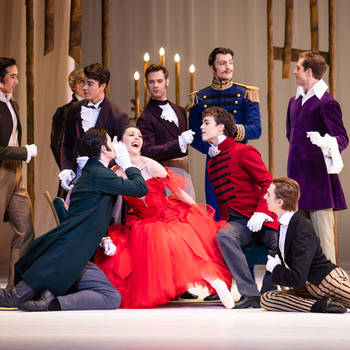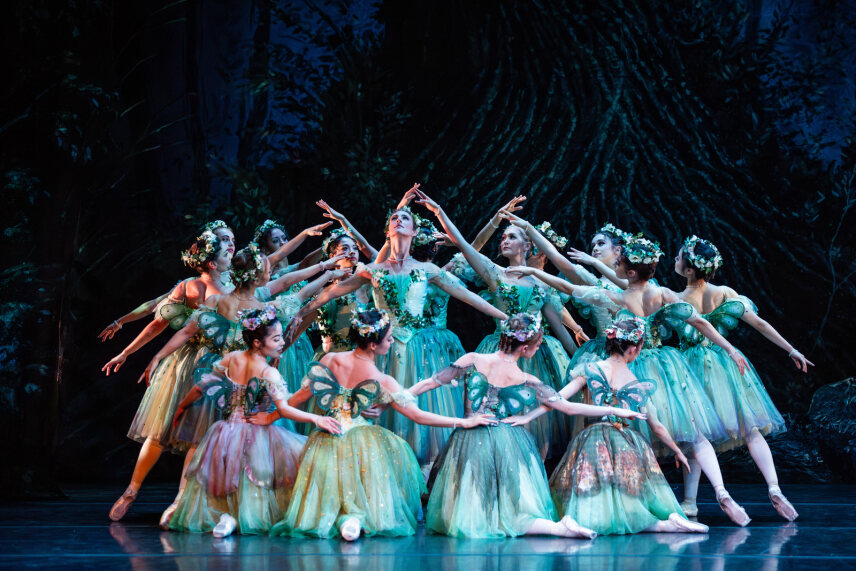As the penultimate production of The Australian Ballet’s diamond jubilee season, a double bill of one-act love stories have been programmed. The 1963 tragedy Marguerite and Armand is followed by the 1964 Shakespeare adaptation, The Dream, both conceived by renowned English choreographer Sir Frederick Ashton.
The choice of programming these two particular productions is a bit of a curious one. The duelling performances, although linked by their matching choreographic voice, could not be more different, thus leading to a slightly unbalanced emotional journey throughout the evening. The cavernous Joan Sutherland Theatre at the Sydney Opera House is the perfect venue for both productions, however, where a blossoming sense of sophistication is architecturally implied.

Set to the timeless score by Franz Liszt, the first act of Marguerite and Armand tells the tragic story of Marguerite, a Parisian courtesan on her deathbed. Through a series of flashbacks, she recalls her tumultuous and largely symbolic relationship with the handsome Armand. It’s a story that we’ve all heard before, with echoes of better source material like Verdi’s La Traviata or the contemporary film Moulin Rouge [and not forgetting George Cukor’s Camille – Ed]. Although the flimsy narrative structure and one-dimensional characters seem too straightforward and shallow for the audience to fully engage emotionally, it is here where Ashton’s choreographic syntax gleams with rich and complex gestures, bringing to mind the hazy yet specific visions of an Edgar Degas painting.
In the performance this reviewer attended Amy Harris played a range of emotions with Marguerite, a role originally conceived for Margot Fonteyn. At first she brought a sickly physicality, to then contrast heavily with her flirtatious and dynamic past-self in the flashbacks. Harris’ expressive acting was visually reminiscent of the silent film star Lillian Gish in her 1919 classic, Broken Blossoms. Much like Gish, Harris delivered a bold, empathetic and memorable performance, which is expected from a performer of her pedigree. She continues to be a delight to watch.
After a brief intermission, the audience is ushered back into the theatre for The Dream, to be greeted by a maximalist enchanted forest set, draped in a series of shades of green; it truly looks like the cosiest spot to lay down for a nap. This production, the longest of the two pieces, is an adaptation of William Shakespeare’s A Midsummer Night’s Dream.
The original text dates back over 400 years and continues to inspire new creative works for its mischievous spirit and universal themes of love and magic. Ashton’s reimagining takes a new approach to the story, stripping the plot to its bare essentials and, of course, of its iconic dialogue. Gone is the famous iambic pentameter of Puck’s fairy coterie, yet in its place is the flawless corps de ballet, who elevate their sequences with elegance and synchronicity.
This translinguistic reimagining is aided by brief interjections from the Sydney Philharmonia Choirs, who support the production by keeping the sound fresh and engaging. By remixing and sampling the universal themes and images of the original text, Ashton is able to uncover ways of looking at movement as language, where bodies are conduits for remarkable twists of storytelling.
In a production full of show-stopping moments, it was Luke Marchant as the humorous Bottom that truly gets the audience laughing (remember, this is a comedy after all). Marchant’s physicality and costume really helped sell his bizarre animal transformation, and he surprised the crowd with his impressive leaping en pointe.
Read: Dance review: CEASE/FIRE, C Shed, Fremantle, WA
As the company winds down from its 60th anniversary celebrations, The Australian Ballet embraces all that makes ballet such a respectable and magnificent art form. With The Dream/Marguerite and Armand, the production teams deliver geometric spectacle, intimidating athleticism and a sense of aesthetic decadence that is rivalled only by the Grand Opera traditions of the 19th century.
The Dream/Marguerite and Armand
Marguerite and Armand
Conductor: Vanessa Scammell
Concert Master: Huy-Nguyen Bui
Solo Pianist: Andrew Dunlop
The Dream
Conductor: Vanessa Scammell
Concert Master: Huy-Nguyen Bui
Casts differs depending on the date performed.
Tickets: from $49
Marguerite and Armand/The Dream will be performed until 25 November 2023.





